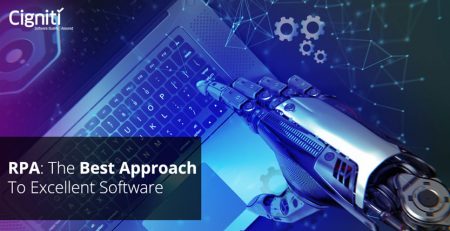Streamlining RPA into the Salesforce Ecosystem
Research firm Gartner estimates the market for hyper-automation enabling technologies will reach $596 billion in 2022, up nearly 24% from the $481.6 billion in 2020. The RPA software market grew 38.9% in 2020 to $1.9 billion and held its position as the fastest-growing segment in the enterprise software market.
Gartner is expecting significant growth in technology that enables organizations to rapidly identify, vet, and automate as many processes as possible and says it will become a “condition of survival” for enterprises. Hyper-automation enabling technologies include robotic process automation (RPA), low-code application platforms (LCAP), AI, and virtual assistants.
As automation technology continues to advance, businesses must learn to exploit it in order to remain competitive. A prime example is robotics, which is used in many industries to perform laborious, repetitive, and time-consuming work. With current advances in technology, robots are no longer science fiction. They might well be your coworkers. Robots, whether physical or RPA, robotic process automation software, are fast becoming an integral part of the workplace.
A software robot, commonly known as Robotic Process Automation, or RPA, by comparison, is a piece of software that mimics what humans do to carry out rules-based tasks. Software robots are used, for example, in automated call centers, where they perform tasks such as redirecting calls to the appropriate department. They can also be used to generate textual content automatically, such as news reports on disaster events, and to automate business processes such as invoicing.
The ANZ banking group uses software robots for a variety of purposes, including transaction investigations, tracing funds, and audit certification. The use of software robots has allowed ANZ to increase their speed, accuracy, and quality, while reducing costs by nearly 40%.
Similarly, software robots can perform many tasks that companies may currently outsource. Organizations considering utilizing robots must plan how to integrate their employees and robots effectively to meet their specific needs.
RPA makes waves in the Cloud
The Salesforce acquisition of Servicetrace comes as no surprise, as Salesforce was keenly watching the ServiceNow acquisition events in March of this year (2021), when ServiceNow took a leap into the robotic process automation (RPA) space when it announced it was acquiring Intellibot, an RPA startup based in Hyderabad, India.
In Jan 2021, SAP announced its acquisition of Berlin-based business process automation startup Signavio. While they specialize in cloud-native BPA tools, this acquisition helped bridge the gap SAP had for a long time and let SAP announce their Intelligent Robotic Process Automation tool, its foray into the RPA space.
The new RPA capabilities will enhance Salesforce’s Einstein Automate solution, enabling end-to-end workflow automation across any system for service, sales, industries, and others. Salesforce understood the need to step up their RPA game-plan. Almost 90% of global organizations have either adopted RPA or plan to do so by 2022, and Salesforce doesn’t want to lag in this space.
Analysts View
Earlier this year, Gartner found that the top three players in this space (RPA) are UiPath, Automation Anywhere, and Blue Prism. And now with major players like IBM, SAP, Pega, Appian, Salesforce, Microsoft, ServiceNow, all bought into the RPA market because for years they didn’t focus on how data got into their systems when operating between organizations or without a human. Instead, they focused more on what happens inside the client’s organization. This has forced businesses to rethink and accelerate trends to drive them to be digitally more efficient by optimizing data ingestion and data flows with RPA capabilities.
One more major trend is the movement to provide no-code tools to allow line-of-business users to create apps and workflows without engineering help, and Mulesoft is leading from the front in this space within Salesforce’s core portfolio of application stacks, as they recently announced Mulesoft Composer and Mulesoft Composer for Salesforce. Both these tools focus on no-code as a prime USP, and with rapid workflow development and deployment by business users entirely.
Gartner’s projection suggested that worldwide RPA revenues will swell to close to US $2 billion by 2021. Gartner also opined that the major challenge to quick deployment of low-code/no-code automation is integrating RPA successfully across heterogeneous, changing environments, which is where IT coordination via multiple platforms is key to making the difference. Also, by 2025, almost every digitally-powered enterprise will be fully-dependent on RPA platforms to drive business processes through agility, scalability, and sustainability.
How RPA augments enterprise operations
Robotic Process Automation can streamline multiple CRM-related business processes, including account, lead, and quotes creation, among other core customer service and contract management activities. RPA has been quite popular with CIOs as an emerging technology that streamlines enterprise operations. It bridges the gaps within business process automation. With RPA, organizations can automate mundane and repetitive rules-based processes, enabling operations teams to devote more time to serving customers, improving products, and other high-value work. Some core examples of RPA automation include,
- An RPA bot can perform sequential actions to automate the lead creation process in Salesforce.
- Using an RPA bot, IT can configure and export Salesforce reports and distribute them to external parties from within the Salesforce platform.
- RPA bots can manage invoice automation by sending invoices within and to external parties from the Salesforce platform by implementing a rule-based algorithm that identifies a common pattern of data within invoices.
- Other RPA processes include transferring PDF and other format files from specific folders or even extracting parametrized data and orchestrating outcomes.
Implementing RPA
Robotic Process Automation, or RPA, has made a major impact on the business world. For instance, a major global bank has implemented RPA to perform several tasks, such as closing fraudulent accounts and handling loan applications. This led to a significant reduction in man-hours and bad debt write-offs.
Another example comes from an insurance firm that uses RPA for claims processing. Four people can now process the same number of claims that it previously took 12 people to complete manually. But successfully implementing RPA requires proper planning and commitment. There are key best practices organizations should follow in implementation.
First, organizations should clearly define their goals for automation. Once the goals are clearly defined, organizations can work backwards to ensure they implement systems in the most effective way. Since RPA is a major investment, this ensures organizations can measure their performance during every phase of implementation. A phased implementation allows organizations to limit their potential losses if the RPA process isn’t meeting their goals instead of committing significant resources from the start.
Second, organizations need to identify champions for implementing RPA. Champions play an integral hand in pushing the idea and adoption of automation. This includes communicating, project vision, motivating team members, and interacting with stakeholders such as senior management. Champions can also be project managers, and organizations should identify those with the skills necessary to effectively complete implementation within budget and on schedule.
Third, organizations must allow business operations to take the lead. Managers in business operations are in the best position to know which processes are most suitable for automation. They have the knowledge and experience to identify those tasks that use structured data, have explicit rules, are stable, and have high transaction volumes. Managers in business operations are also able to identify the processes that provide the maximum benefit to employees and customers when automated.
Benefits and Risks of Robot Process Automation
In contrast to physical robots, software robots allow companies to automate certain processes in what’s known as robot process automation, or RPA. RPA has a variety of uses. It can be used in telecommunications.
For example, automated call centers can place pre-recorded calls, such as appointment reminders and customer surveys. RPA can also be used to create content. The Los Angeles Times uses a software robot to automatically create news reports about earthquakes from data compiled from the US Geological Survey website. And software robots are also used to process things like invoices, by reading, validating, and cross-checking them before either approving or flagging them for further action.
There are many benefits to RPA. First, software robots work faster than people, allowing for the processing of more data in the same amount of time, which can also improve customer service. Further, RPA can perform simple tasks on behalf of employees, which frees employees to do more meaningful work, increasing job satisfaction. Additionally, RPA provides companies with an increased level of compliance. Software robots log all their actions, making it easier for employees to run internal reviews and ensure process compliance. This also makes it easier to stay compliant as regulations and standards become increasingly complex.
Finally, RPA is non-invasive. It utilizes the user interface of applications and platforms just like a human would, generally, eliminating the need to change existing systems during implementation and eliminating interruptions during changeover. The benefits of RPA are clear, but not without risks. Errors in algorithms can cause mistakes that humans might not make. Since these robots work so quickly, even small, and infrequent errors can spiral out of control quickly.
For example, a robot that handles loan applications with an error rate of 1% might mistakenly approve thousands of high-risk loans in a single day. There are, however, ways to manage these risks. First, run a pilot program. The benefits of RPA tempt companies into a large scale rollout, but it’s much easier to manage a small number of robots at first.
Companies should test their pilot group for a period of time, gathering data, and ensuring performance standards. They should make note of any changes required before the system can be fully implemented. Additionally, companies should give RPA separate credentials for logging in, allowing them to distinguish the actions carried out by RPA from those of human employees. Further, having software robots run on virtual machines inside the system instead of logging onto a desktop further eliminates security risks.
Power failures, for example, can negatively impact desktop-driven RPA and cause costly errors. Additionally, businesses must ensure they don’t lock in system weaknesses or neglect improving the underlying process once software robots are implemented. This limits the long term effectiveness of the RPA. They also need to ensure that knowledge of the automated processes is retained. This allows employees to verify that the RPA is receiving the correct data and that their procedures are correctly defined. This ensures companies can fall back on manually completing a process should the robots fail. Businesses that invest wisely in RPA, while working to mitigate the risks, see significant returns and put themselves in a position for continued and future competitive success.
By automating a considerable number of routine and non-revenue generating manual tasks related to Salesforce CRM, RPA technology helps small-or-large businesses to reduce their administrative costs and make RPA implementation a more profitable decision for them.
Conclusion
Finally, organizations must involve IT early in the implementation project. While some organizations may not see the need to involve IT, there are many benefits to involving them as early in the process as possible. IT are the ones most capable of vetting software robots to ensure they don’t compromise system security, and they can develop access rules to prevent software robots from exposing sensitive data. They will ultimately be responsible for maintaining a secure and backed up infrastructure for the robots to run on.
Whether a company is implementing RPA as a standalone solution or as part of a larger automation initiative that may include physical robots or other forms of AI, planning, preparation, risk mitigation, and following best practices ensure success and smooth transition.
Need help? Talk to our RPA and Salesforce testing domain experts to find out more about streamlining RPA into the Salesforce ecosystem.





Leave a Reply